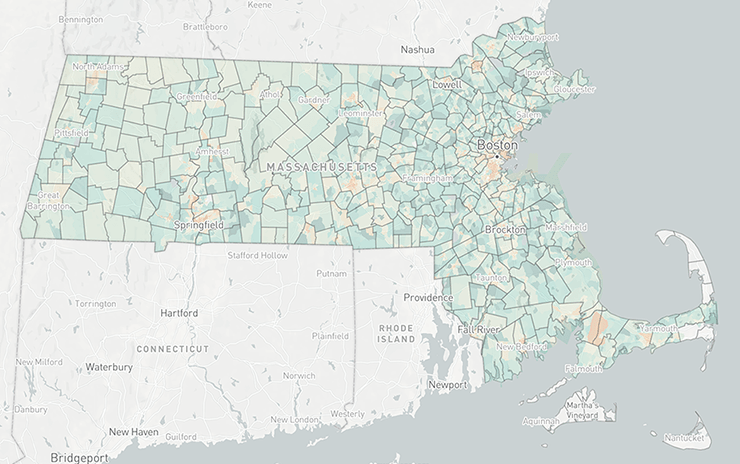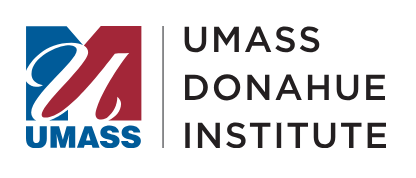FY ’17: Group Quarters Electronic Response (GQER)
The GQER test is a component of the 2020 Research and Testing Study Plan conducted by the U.S. Census Bureau’s Special Enumerations Integration Team. It tests the quality of electronic submissions and supporting the address frame for 2020 Census of Group Quarters population enumeration. Massachusetts was the only state to participate in this test, submitting data on 1,918 student housing and nursing home facilities around the Commonwealth.
FY ’17: Geographic Support System Initiative (GSS-I)
The Bureau’s Geographic Support System Initiative (GSS-I) allows governmental entities to submit geocoded address data for review, validation, and inclusion in the Bureau’s Master Address File, ensuring that the maximum number of residential addresses will be in scope for Census 2020 operations. In fiscal year 2017, UMDI prepared and submitted 2.8 million geocoded residential addresses to the U.S. Census Bureau, using data from the MassGIS NextGen e-911 Database, the Level 3 Assessors’ Parcel Data, and voter address lists from the Massachusetts Secretary of the Commonwealth. The Bureau was able to add or correct spatial coordinates for over 1 million residential addresses in Massachusetts based on our submission.
FY ’18, ’19: Local Update of Census Addresses (LUCA) 2020
The LUCA program provides an opportunity for tribal, state, and local governments to review and update the address lists and maps used to conduct the 2020 Census. Critically, if an address is not included in the Census Master Address File, it will not receive a Census form or visit. LUCA provides the opportunity for local governments and the state, acting on their behalf, to add addresses that the Census Bureau has missed to the Master Address File, ensuring that all Massachusetts households are included in the 2020 Census.
To ensure a successful LUCA project in Massachusetts, UMDI and the Secretary of the Commonwealth’s Office combined information from the MassGIS E911 database, Assessors’ Parcel data, and de-personalized address data from the State Voter Address list to create an updated statewide residential address list, including detailed property use-codes and geographic coordinates. These LUCA-ready list were distributed to cities and towns around the Commonwealth to assist them in their review. In addition, the UMDI/SOC team conducted 14 regional and statewide Census 2020 LUCA Technical Training presentations in all regions of the Commonwealth, from Pittsfield to Barnstable, with approximately 400 city and town representatives registered statewide.
While hundreds of cities and towns completed their own LUCA reviews with our support, the UMDI/SOC team also acted as “insurance” for the state, completing a detailed review and submission for non-participating towns, and a prioritized review as a back-up for participants. Ultimately, the UMDI/SOC team submitted 100,454 residential addresses and 325 group quarters facilities that the Census Bureau had potentially missed or misplaced, with thousands of additional addresses submitted directly by the municipalities we supported.
FY ’19: Early Non-Response Follow-up Recommendations (Early NRFU)
Early NRFU specifically targets residential areas around colleges, where students may leave the area before the Census has had a chance to reach out to non-responders. UMDI completed an analysis to identify neighborhoods in our state that will benefit from Early Non-Response Follow-Up in the 2020 Census. We created a geodatabase that pulled in layers of college campuses; ACS and Census data on household, age, and enrollment information; digitized bus and MBTA routes; and de-identified student addresses from colleges and universities throughout Massachusetts. Applying buffer zones and criteria indexing, we ultimately identified 2,863 off-campus college blocks which we submitted to the U.S. Census Bureau for their consideration in their Early NRFU operations.
FY ‘19-‘20: Group Quarters Address Frame
The 2020 Group Quarters Address Frame project allows state representatives from the Federal State Cooperative for Population Estimates (FSCPE) the opportunity to submit addresses, locations, and contact information for group quarters facilities and transitory locations on behalf of their states. The Massachusetts FSCPE representative from UMDI requested and advocated for this opportunity for all states with the understanding that while municipalities may submit their own group quarters addresses as part of the LUCA review, for some facility or location types statewide administrative resources and research can provide comprehensive information that might otherwise be missed. Addresses submitted through this project will be incorporated into the Census Master Address File in time for enumeration planning activities to be prepared by the Bureau for these locations. The GQ address frame project will be conducted from approximately March through August of 2019.
FY ’19- ’20: New Construction Survey
The U.S. Census Bureau typically conducts a New Construction Survey just ahead of the Census enumeration effort so that local governments can submit addresses or developments that have come online (or will be constructed before the April 1st Census count) since the LUCA review start period (March 2018). In areas of high growth, especially Eastern Massachusetts and the Greater Boston and Greater Worcester areas, capturing new residential developments will be critical for ensuring a full Census count. UMDI will work with the Secretary of the Commonwealth’s office on outreach, education, and technical support to municipalities working on the New Construction Survey, and will compile data for submission on behalf of Massachusetts municipalities. In scope: For new construction in progress on or after March 1, 2018, with completion anticipated by April 1, 2020. Anticipated schedule: April 2019 New Construction Survey invitation goes out; July 2019 NCS registration deadline; September 2019 materials mailed to participants; 45 days to provide new construction after receipt of materials.
FY ’19- ’21: Count Review Program
The Count Review Program (CRP) provides a last-chance opportunity for Federal-State Cooperative for Population Estimates (FSCPE) state liaisons to review the Census Bureau’s Master Address File before the official Census count day (for housing units) and after enumeration (for group quarters) so that missed addresses and facilities can be restored to the Census. UMDI participates in this project by assembling a statewide geodatabase of residential addresses and group quarters facilities for comparison against the Master Address File. For example, in the 2010 Count Review program, UMDI was able to restore 2,735 residential addresses and numerous facilities to the enumeration which would have otherwise been missed. According to the Census Bureau, as many as 1 out of 98 housing units was enumerated because of Count Review at the state level in Census 2010.
Preparations for count review operations, including training to state participants and the assembling of address lists, will begin in late 2018 (FY ’19), and the two review events will take place in January to February and June to July of 2020 (FY ‘20 and ‘21.) States can elect to participate in either or both of these review events, which are strategically designed to provide a realistic chance of identifying and correcting potential errors in each state’s census counts.
FY ‘21- ‘23: Count Question Resolution
The Census Bureau established the Census Count Question Resolution (CQR) Program to allow state, local and tribal area elected officials to challenge their jurisdiction's decennial Census counts. The CQR typically begins about one year after the census date, and runs for approximately two years. The data eligible for correction in the CQR program include housing units and group quarters population at the block level, as well as boundary corrections. If a challenge results in a change, the Census Bureau will issue official revised counts to the affected governments. Once the CQR program concludes, there are no additional opportunities to add missed housing units or missed group quarters facilities to the decennial census base.



